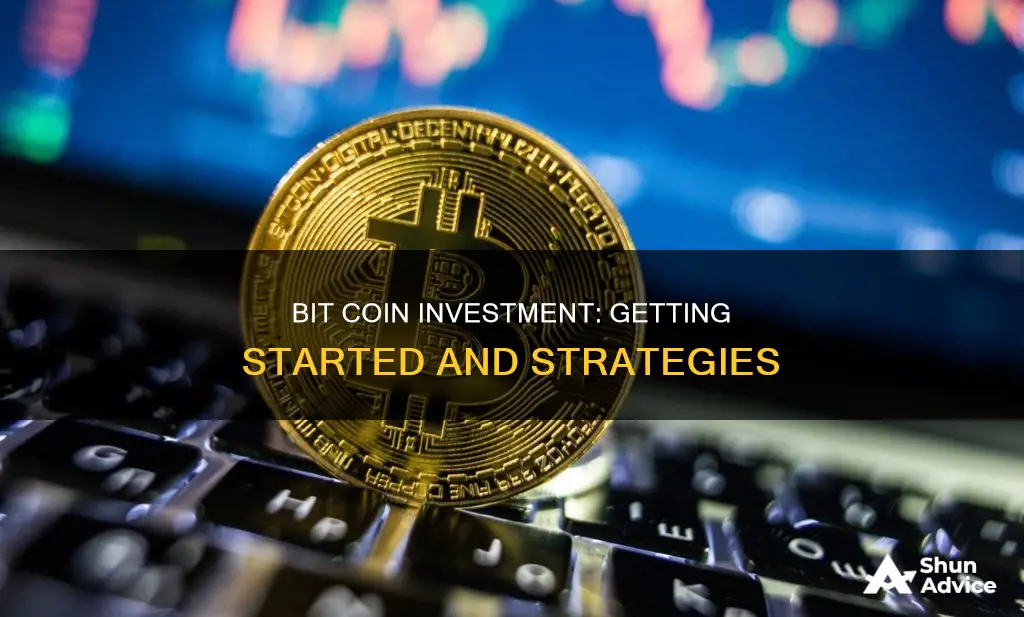
Bitcoin is a cryptocurrency, a type of digital asset that functions as a means of exchange, much like the money in our wallets. Unlike fiat currency, which is issued by central banks, cryptocurrencies are typically not issued or controlled by any central authority or government. Instead, they are managed by blockchain technology, a decentralised, distributed ledger that records transactions across many computers, making it difficult to alter or delete previous transactions.
Bitcoin was launched in early 2009 by an anonymous creator under the pseudonym Satoshi Nakamoto. It is the largest cryptocurrency measured by market capitalisation. Only approximately 21 million bitcoins will ever be created, which explains its scarcity and high price.
There are several ways to invest in Bitcoin. You can use a cryptocurrency exchange, a traditional stockbroker, a money transfer app, a Bitcoin ATM, or a Bitcoin exchange-traded fund (ETF). When investing in Bitcoin, it is important to consider the risks involved, as it is a highly volatile asset.
| Characteristics | Values |
|---|---|
| How to invest | Buy Bitcoin through a crypto exchange, traditional stockbrokers, money transfer apps, Bitcoin ATMs, or Bitcoin ETFs. |
| Where to buy | Crypto exchanges such as Gemini, Kraken, Coinbase, Crypto.com, Binance, and Robinhood. |
| Payment methods | Bank account, debit card, credit card, or PayPal. |
| Storage options | Hot wallet (online) or cold wallet (offline). |
| Risks | Volatile asset, susceptible to hacking, largely unregulated, and no consumer protection. |
What You'll Learn

Choose a crypto exchange
Crypto exchanges are platforms that allow users to buy, sell, and trade cryptocurrencies. There are hundreds of crypto exchanges available, so it is important to choose the right one for you. Here are some factors to consider when selecting a crypto exchange:
Authenticity and Security
Firstly, you should research the legitimacy and security of a platform. The authenticity and security of an exchange will ensure the safety of your funds. Scam platforms have caused traders to lose billions of dollars. Check the reputation of the platform and the security protocols they have in place to protect your data and money.
Payment Options
Different platforms support different payment methods. Some common methods include bank transfers, PayPal, credit and debit cards, and cryptocurrency. Choose a platform that supports your preferred payment method. If you are new to crypto, select an exchange that accepts fiat currency to make the process less stressful.
Supported Coins and Tokens
While most crypto exchanges support Bitcoin and Ethereum, there are thousands of other cryptocurrencies. If you want to trade cryptocurrencies other than Bitcoin and Ethereum, you should check which coins and tokens are supported by the exchange. Binance, for example, offers access to more cryptocurrencies than other platforms.
Transaction Fees
The transaction fee structure varies across crypto exchanges. Understand the fee structure of an exchange before signing up. Choose a platform with no hidden transaction fees and one that suits your trading frequency and volume.
User Interface and Experience
The user interface and experience of an exchange are important for your success as a trader. An intuitive interface makes it easier to trade cryptocurrencies. However, user experience is subjective, and different people prefer different interfaces. Also, consider the customer service and other customer-related functionalities offered by the exchange.
Regulation and Security
The crypto world is often considered the "wild west", with less regulation and government involvement compared to other financial markets. This allows for anonymous trading but increases security risks. Consider an exchange that provides two-factor authentication and/or multi-signature functionality for accounts. Additionally, look for an exchange that pools user funds and stores a large percentage in cold storage, reducing the risk of losing all funds in a hack.
Reviews and Reputation
Check reviews and the reputation of an exchange before signing up. See what other users have to say about their user experience, security, and customer service. Also, check the exchange's rating with organisations like the Better Business Bureau.
US Mint Specialty Coins: Worth the Investment?
You may want to see also

Decide on a payment method
After choosing an exchange, you have to fund your account before you can begin investing in bitcoin. Depending on the exchange, you can fund your account in several ways, including bank transfers, PayPal, a cryptocurrency wallet, or even a debit or credit card. Exchanges operating in Australia typically offer instant AUD deposits using PayID.
Because fees reduce how much money you can invest (and therefore also how much money you have to grow and compound), it makes sense to use electronic transfers from a bank account rather than other methods. In addition, if you use a credit card to buy cryptocurrency, it generally will count as a cash advance and be subject to a higher interest rate than you pay on regular charges. Remember that taking on debt to buy volatile investments is extremely risky.
You can decide which exchange is right for you by reading up on the top exchanges for Australians.
Once your account is funded, you can place your first order to buy bitcoin. Depending on the platform you’re using, you may be able to purchase it by tapping a button, or you may have to enter bitcoin’s ticker symbol (BTC). You’ll then have to input the amount you want to purchase. When the transaction is complete, you will own a portion of a bitcoin.
That’s because it requires a large upfront investment to buy a single bitcoin now. If bitcoin’s current price was $100,000, for example, you’d need to invest that much to buy a full bitcoin. If you invested less, say $1000, you’d get a percentage, in this case 1%, of a single bitcoin.
Payment methods to avoid
While you can use a credit card to buy bitcoin, it is not recommended. Credit card processing can tack on extra charges to such transactions. In addition to paying transaction fees, there may be processing fees that the exchange may pass onto the buyer. Credit card issuers treat bitcoin purchases as cash advances and charge hefty fees and interest rates on such advances.
The Next Big Thing: What's Outpacing Bitcoin?
You may want to see also

Place an order
Once you have chosen a crypto-trading service or venue, connected it to a payment option, and decided how much to invest, you can place an order for your chosen cryptocurrency.
Almost all crypto exchanges offer both market and limit orders, and some also provide stop-loss orders. A market order is an instruction to buy or sell a cryptocurrency immediately at the best available price. A limit order is an instruction to buy or sell a cryptocurrency at a specific price or better. A stop-loss order is an instruction to sell a cryptocurrency if its price falls to a particular level, in order to limit your potential losses.
Some exchanges offer a wider range of order types. For example, Kraken offers market, limit, stop-loss, stop-limit, take-profit, and take-profit limit orders. A take-profit order is an instruction to sell a cryptocurrency when it reaches a particular price, in order to lock in profits. A take-profit limit order combines the features of a take-profit order and a limit order: it is an instruction to sell a cryptocurrency when it reaches a particular price, but only if that price is available.
Exchanges also offer ways to set up recurring investments, allowing clients to dollar-cost average into their investments of choice. For example, Coinbase lets users set recurring purchases for every day, week, or month.
Bitcoin vs Gold: Which is the Better Investment?
You may want to see also

Select a safe storage option
When you purchase Bitcoin, you must carefully consider how you will store it. Bitcoin storage is a critical component of owning and investing in the currency, and there are a variety of options available, each with its own advantages and disadvantages. Here are some safe storage options to consider:
Cryptocurrency Exchange Wallets
If you buy Bitcoin through a cryptocurrency exchange like Coinbase or Binance, you will typically be offered an online wallet where you can store your digital assets. These wallets are convenient and easy to use, especially for beginners, as the exchange manages the technical side of secure storage. Many exchanges also provide insurance against potential losses, adding an extra layer of security. However, it's important to remember that you don't control the private keys to your wallet, which means you don't fully control your Bitcoin. Additionally, while exchanges have improved their security measures, they can still be vulnerable to hacking attempts and other malicious activities. As such, it's generally recommended not to use an exchange wallet for long-term storage.
Hot Wallets
Hot wallets are Bitcoin wallets that are connected to the internet, making them convenient for frequent transactions. They can come in the form of web wallets, desktop wallets, or mobile wallets. Web wallets are hosted by a third-party company and can be accessed from any web browser, providing easy accessibility. Desktop wallets are downloaded and installed on your computer, offering more security than web wallets as you control the private keys. Mobile wallets, as the name suggests, run on your smartphone, making them extremely portable and useful for in-person purchases. While hot wallets are convenient, their constant connection to the internet makes them more susceptible to cyber-attacks and hacking attempts.
Cold Wallets
Cold wallets, or offline wallets, are considered the most secure option for storing Bitcoin. They keep your private keys offline, making it nearly impossible for hackers to access your funds. Hardware wallets, which are physical devices that store your private keys, are one of the most popular types of cold wallets. These devices, such as the Ledger Nano or Trezor, connect to your computer or smartphone when you need to make a transaction, and then safely store your private keys when not in use. Cold wallets also include paper wallets, which are physical documents containing the private keys and a QR code. While cold wallets offer superior security, they may be less convenient for frequent traders due to the manual process of setting up transactions.
Multi-Signature Wallets
Multi-signature wallets, or multi-sig wallets, require multiple private keys for a transaction to be approved, adding an extra layer of security. These wallets are ideal for businesses or individuals looking for more secure storage options. You can set up a multi-sig wallet to require the approval of multiple people or devices before a transaction can be made, reducing the risk of unauthorized access. This type of wallet is especially useful for large Bitcoin holdings, as it provides an added layer of protection against theft or loss.
When choosing a storage option, it's essential to consider your needs and priorities. If you're a long-term investor looking for maximum security, a cold wallet may be the best option. On the other hand, if you plan to actively trade or need quick access to your Bitcoin, a hot wallet or exchange wallet might be more suitable. It's also important to remember that you can use multiple storage options to balance security and convenience. Ultimately, the best storage method depends on your individual needs and comfort level with different types of wallets.
Vechain Coin: A Smart Investment Decision?
You may want to see also

Manage your investments
Once you've decided to invest in Bitcoin, you'll need to consider how to manage your investment. Here are some key things to keep in mind:
- Vetting and Monitoring Your Investment: It's important to thoroughly research any cryptocurrency before investing. Cryptocurrencies are highly volatile and unpredictable, so it's crucial to understand the risks involved. Remember that anyone can launch a cryptocurrency, and the regulatory landscape is constantly evolving. Stay informed about market trends and news that could impact your investment.
- Diversification: Diversifying your investment across multiple cryptocurrencies can help manage risk. While Bitcoin is the most well-known and dominant force in the market, there are thousands of other cryptocurrencies, each with its own unique features and applications. Spreading your investment across different options can reduce the impact of price swings in any single currency.
- Regular Investing and Rebalancing: Consider adopting a strategy of regular investing, where you invest a fixed amount at regular intervals. This approach, known as dollar-cost averaging, can help smooth out the impact of price volatility. Periodically review your portfolio to assess whether you need to rebalance your holdings. This may involve increasing or decreasing your crypto exposure based on your investment goals and financial needs.
- Long-Term Perspective: Cryptocurrencies are subject to rapid price fluctuations, and it's easy to get caught up in the short-term excitement or panic. Maintaining a long-term perspective can help you avoid making impulsive decisions. Remember that the value of your investment can go up or down quickly, and sometimes dramatically.
- Risk Management: Be mindful of your risk tolerance and investment goals when deciding how much to invest in Bitcoin. It's generally recommended to invest no more than a small percentage of your net worth or overall portfolio in cryptocurrencies. This helps to limit your exposure to crypto-specific risks and ensures you don't invest more than you can afford to lose.
- Transaction Fees: When buying or selling Bitcoin, pay attention to the transaction fees charged by exchanges or brokers. These fees can vary widely and eat into your profits. Compare the fees across different platforms to find the most cost-effective option.
- Security: Keeping your Bitcoin secure is essential. Use reputable exchanges and digital wallet providers that offer strong security measures, such as two-factor authentication and encryption. Protect your private keys and passwords, and be vigilant about phishing scams targeting crypto users.
Understanding Bitcoin: What Your Investment Really Means
You may want to see also







